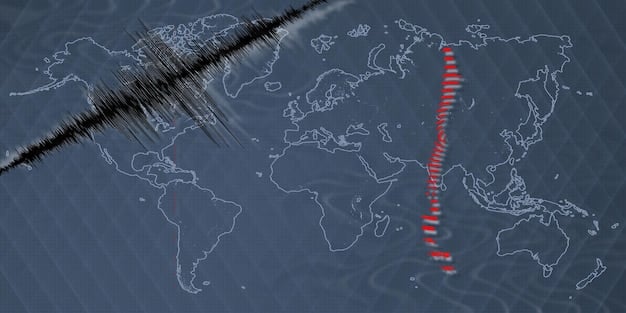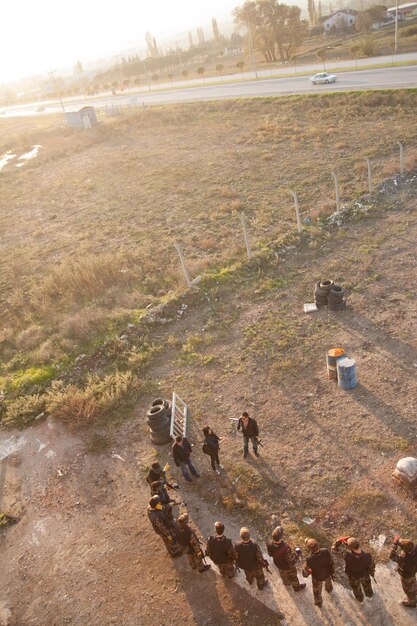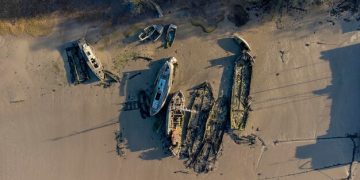Japan Earthquake & US Military Alliances: Impacts Analyzed

A major earthquake in Japan could significantly disrupt US military alliances, impacting regional stability and global power dynamics by straining logistical capabilities, economic resilience, and humanitarian aid efforts.
The intricate tapestry of global geopolitics is often shaped by unseen forces, not least among them the raw power of natural disasters. When considering the critical security architecture of the Indo-Pacific, the potential for a catastrophic seismic event in Japan looms large, promising profound and multifaceted repercussions. This article delves into the critical task of analyzing the potential consequences of a major earthquake in Japan on US military alliances, exploring how such an event could recalibrate regional defense strategies, strain bilateral cooperation, and reshape the strategic landscape.
Understanding the US-Japan Alliance’s Foundations
The alliance between the United States and Japan is a cornerstone of peace and security in the Indo-Pacific, serving as a critical bulwark against regional instability. For decades, this partnership has evolved from a post-war military occupation to a comprehensive security and economic cooperation, reflecting shared democratic values and mutual strategic interests. Its foundational elements include robust defense cooperation, intelligence sharing, and extensive joint exercises designed to enhance interoperability and readiness in various scenarios, from conventional warfare to humanitarian aid and disaster relief (HADR).
Historical Context and Strategic Imperatives
The alliance’s historical trajectory highlights its adaptive nature. Initially centered on Article V of the Security Treaty, which obligates the United States to defend Japan, the alliance broadened its scope significantly in the post-Cold War era. Japan’s role has expanded from a host nation for US forces to an active security partner, increasingly contributing to regional and global security efforts. The strategic imperatives underpinning this alliance are multifaceted, encompassing deterrence against potential adversaries, maintaining freedom of navigation, upholding a rules-based international order, and responding to evolving threats, including cyber warfare and climate change impacts.
- Article V Commitment: The core of the alliance, outlining mutual defense obligations.
- Host Nation Support: Japan’s significant financial and logistical contributions to maintaining US forces.
- Joint Exercises: Regular large-scale drills such as “Keen Sword” and “Orient Shield” that enhance readiness.
- Regional Stability: The alliance’s role in counterbalancing rising military powers and addressing territorial disputes.
This enduring partnership is not merely transactional; it is deeply embedded in the strategic calculations of both nations. The US forward presence in Japan, including naval assets (e.g., the USS Ronald Reagan carrier strike group operating from Yokosuka) and air power (e.g., Kadena Air Base), provides a rapid response capability crucial for regional contingencies. Japan’s Self-Defense Forces (SDF), while operating under constitutional limitations, are highly capable and increasingly integrated with US forces, forming a formidable combined defense posture. The sheer scope and depth of this interoperability mean that any major disruption to one party inevitably affects the other, underscoring the delicate balance of their shared security environment. A major earthquake, therefore, presents not just a domestic Japanese crisis but a profound challenge to allied operational readiness and strategic planning.
Immediate Impacts on US Military Infrastructure and Personnel
A major earthquake in Japan would undoubtedly inflict immediate and severe damage on US military infrastructure and personnel stationed across the archipelago. The geographical distribution of US bases, particularly those concentrated in heavily populated and seismically active areas, renders them highly vulnerable. Facilities such as Yokosuka Naval Base, Kadena Air Base, Marine Corps Air Station Futenma, and Sasebo Naval Base are integral to US Indo-Pacific command operations, harboring tens of thousands of personnel, their families, and substantial military assets.
Damage to Critical Facilities and Logistics
The direct physical consequences could range from structural damage to buildings, runways, and piers to the disruption of utilities like power, water, and communications. Earthquakes can cause liquefaction, landslides, and tsunamis, further exacerbating the damage, especially to coastal facilities. Such damage would immediately impair operational capabilities, making it difficult to launch, land, or dock assets, effectively crippling large segments of the forward-deployed force. The sheer scale of potential damage would demand immense resources for assessment, stabilization, and repair, diverting vital military assets and personnel from their primary defense missions towards disaster response and recovery.
Logistical networks, already complex due to Japan’s island geography, would face overwhelming challenges. Roads, railways, and bridges—essential for moving supplies, equipment, and personnel—could be severed, hindering internal movement and external aid efforts. Ports and airfields, critical for receiving relief supplies and reinforcements, might be damaged or rendered unusable, creating bottlenecks that severely impede the response. Without functioning logistical arteries, the ability of US forces to sustain operations, support local recovery efforts, or even self-evacuate non-essential personnel would be severely compromised.
- Infrastructure Degradation: Runways, port facilities, living quarters, and command centers at risk.
- Loss of Utilities: Power outages, water supply disruption, and communication blackouts.
- Personnel Casualties: Direct injuries or fatalities among service members and their families.
- Operational Impairment: Difficulty in deploying or receiving military assets and personnel.
The impact on personnel would be equally profound. Casualties among service members and their families are a grim possibility, placing immediate strain on medical services and morale. Even for those unharmed, the psychological toll of experiencing a major disaster and the ensuing chaos cannot be overstated. Ensuring their safety and well-being, along with search and rescue operations, would become the paramount concern, temporarily overshadowing strategic objectives. The response effort would require coordination with Japanese authorities, further challenging an already stressed system. This profound shift from defense readiness to disaster relief would represent a critical test for the alliance, potentially exposing vulnerabilities in their joint disaster preparedness and response protocols.

Disruption of Joint Operations and Deterrence Posture
The immediate consequences of a major earthquake on US military infrastructure in Japan would ripple outwards, significantly disrupting joint US-Japan operations and potentially weakening the alliance’s overall deterrence posture in the Indo-Pacific. The strategic value of the US forward presence lies in its ability to project power swiftly and credibly. When bases are damaged, personnel are engaged in recovery, and logistical lines are severed, this capability is inherently diminished.
Challenges to Combined Readiness and Response
Joint exercises, which are fundamental to developing interoperability and mutual understanding, would likely be postponed or drastically scaled back. The collective training and readiness that such exercises foster would suffer, impacting the seamless coordination expected in a crisis. For instance, planned air-to-air refueling operations or naval escorts, critical components of a combined defense, might become unfeasible. This degradation in readiness could extend beyond immediate post-quake challenges, taking months or even years to fully recover, depending on the scale of reconstruction required.
Beyond exercises, the real-world ability to respond to regional contingencies would be severely hampered. Imagine a scenario where a crisis in the Taiwan Strait or the Korean Peninsula escalates shortly after a major earthquake in Japan. US forces, preoccupied with disaster relief and internal recovery, would find it challenging to deploy effectively or fulfill treaty obligations. Japan’s Self-Defense Forces, likely overwhelmed with domestic humanitarian aid and disaster relief (HADR) efforts, might also struggle to provide their usual level of support or participate in joint defense actions. This creates a dangerous strategic vacuum, potentially inviting opportunistic actions from regional adversaries who might perceive a weakened or distracted alliance.
- Delayed Response: Slower deployment of forces to regional flashpoints.
- Resource Diversion: Focus shifts from defense to disaster recovery.
- Reduced Interoperability: Decreased ability for US and Japanese forces to work together effectively.
- Perceptional Weakness: Risk of adversaries viewing the alliance as temporarily compromised.
The direct impact on deterrence stems from this perceived vulnerability. Deterrence relies not only on capability but also on the credible projection of that capability and the unwavering will to use it. If a major earthquake renders significant portions of US forces in Japan temporarily non-operational or diverts substantial Japanese resources to domestic recovery, potential adversaries might be tempted to test the alliance’s resolve. This could manifest as increased assertiveness in disputed territories, intensified naval or air incursions, or more aggressive rhetoric, all aimed at probing the limits of the alliance’s temporarily compromised strength. The dual challenge of responding to a natural disaster while simultaneously maintaining a robust defense posture would be an unprecedented strain on the US-Japan alliance, highlighting the need for contingency planning that transcends traditional military scenarios.
Economic and Political Fallout in Both Nations
The economic and political fallout from a major earthquake in Japan would reverberate far beyond its borders, sending shockwaves through the global economy and potentially straining the political fabric of both the United States and Japan. The interconnectedness of modern economies means a disaster of this magnitude in one of the world’s leading industrial powers has cascading effects.
Economic Disruption and Supply Chain Vulnerabilities
Japan is a global leader in technology, automotive manufacturing, and precision components. A major earthquake would paralyze key industrial zones, disrupt intricate supply chains, and cause significant losses in production. This would not only impact Japanese GDP but also create ripple effects worldwide, particularly for industries reliant on Japanese parts and innovations, including American companies. Consumer electronics, semiconductors, and automobile production would face immediate bottlenecks, leading to price increases and potential shortages in the US market. The costs of reconstruction in Japan would be astronomical, potentially diverting national resources from other critical areas, including defense spending.
Politically, the US government would face intense pressure to provide massive humanitarian and financial aid, potentially at the expense of other domestic or international priorities. There would be a delicate balance between supporting a crucial ally and managing public sentiment, particularly if the US economy were also facing challenges. In Japan, the political leadership would be under immense scrutiny to manage the crisis effectively, deliver aid, and oversee reconstruction. Failure to do so could lead to political instability, potentially impacting the continuity and stability of the government, which in turn could affect the steadfastness of the alliance.
- Global Supply Chain Interruptions: Delays and shortages for industries reliant on Japanese components.
- Economic Downturn: Impact on Japanese and potentially global GDP, affecting trade and investment.
- Aid Requirements: Significant US financial and humanitarian aid, potentially shifting budget priorities.
- Political Scrutiny: Leadership in both nations facing pressure to manage crisis and recovery effectively.
Furthermore, a protracted recovery period could lead to social unrest in affected regions of Japan, requiring sustained government attention and resources. The perception of the US’s rapid and effective response would be crucial in reinforcing the alliance’s value. Conversely, any perceived slowness or inadequacy could foster resentment and potentially weaken public support for the defense partnership in Japan. The economic and political stability of both nations is intrinsically linked to the health of the alliance, and a major seismic event would test their resilience on multiple fronts, demanding astute diplomacy and robust cooperative frameworks to navigate the complexities of recovery and maintain long-term stability.
Humanitarian Aid and Disaster Relief (HADR) Mobilization
A major earthquake in Japan would trigger an immediate and unprecedented mobilization of humanitarian aid and disaster relief (HADR) efforts, with the US military playing a pivotal role. The US-Japan alliance explicitly includes provisions for HADR cooperation, a testament to their deep partnership, but a truly catastrophic event would test the limits of these capabilities and their coordination mechanisms.
Operational Challenges and Priorities
The initial phase of HADR would involve search and rescue operations, medical assistance for the injured, and provision of basic necessities like food, water, and shelter for displaced populations. US forces, particularly those with specialized engineering and medical units, would be critical in supplementing Japan’s own highly capable Self-Defense Forces. However, the very infrastructure needed to deliver this aid—ports, airfields, roads—might be severely compromised, creating immense logistical hurdles. Aid efforts would need to navigate widespread destruction, communication blackouts, and potential aftershocks, often in an environment where local authorities are themselves overwhelmed.
Prioritizing aid delivery would become a complex challenge, balancing immediate life-saving efforts with the longer-term needs for re-establishing essential services and preparing for reconstruction. The sheer volume of supplies required would demand extensive airlift and sealift capabilities, possibly diverting assets from other strategic areas or requiring assistance from other allied nations. The coordination between diverse agencies—Japanese government entities, US military commands, NGOs, and international organizations—would be paramount to avoid duplication of effort and ensure efficient resource allocation.
- Search and Rescue: Immediate deployment of specialized teams and equipment.
- Medical Support: Establishing field hospitals and providing emergency care.
- Logistical Bottlenecks: Damaged infrastructure hindering aid distribution.
- Inter-agency Coordination: Complex management of diverse relief organizations.
Beyond immediate relief, HADR operations would transition to supporting stabilization and early recovery. This might involve clearing debris, restoring critical infrastructure (even temporarily), and providing engineering support. The US military’s heavy construction capabilities, such as those of the Seabees, would be invaluable in clearing roads and stabilizing damaged structures. However, these are finite resources, and their extensive deployment in Japan could affect US military readiness elsewhere in the Indo-Pacific. The enduring success of such an operation would not only save lives and alleviate suffering but also powerfully reaffirm the strength and resilience of the US-Japan alliance in the face of shared adversity, potentially fostering deeper trust and cooperation in the long run.

Long-Term Strategic Realignments and Preparedness
The long-term consequences of a major earthquake in Japan on US military alliances would extend beyond immediate recovery, potentially triggering significant strategic realignments and necessitating a fundamental re-evaluation of preparedness strategies. Such an event would serve as a harsh stress test for the alliance, revealing vulnerabilities and catalyzing changes in defense planning and resource allocation.
Rethinking Forward Presence and Distributed Operations
A major earthquake could compel the US to reassess its strategy of heavily concentrated military assets in a seismically active zone. The vulnerability exposed might accelerate existing discussions on force posture adjustments, potentially leading to greater emphasis on distributed operations, where forces are spread across multiple, smaller, and less vulnerable locations, or even repositioning some assets to other allied nations in the Indo-Pacific. This shift would aim to enhance resilience and ensure that a single catastrophic event does not cripple a significant portion of US regional capabilities.
For Japan, the priority would undoubtedly shift towards enhancing seismic resilience for critical infrastructure, including military bases and dual-use facilities. This could involve massive investments in earthquake-resistant construction, early warning systems, and robust civilian-military coordination mechanisms for disaster response. The experience would likely spur greater self-reliance in immediate disaster relief, potentially freeing up US assets for broader regional security roles if needed.
- Force Posture Review: Reassessment of base locations and concentration of assets.
- Distributed Operations: Increased focus on spreading forces across wider geographical areas.
- Resilience Investments: Japan’s increased spending on earthquake-proofing infrastructure.
- Allied Diversification: Potential for greater security cooperation with other regional partners to share burdens.
Furthermore, the scale of recovery efforts would test the financial and political will of both nations over an extended period. Sustained aid from the US, coupled with Japan’s own reconstruction projects, would necessitate careful budgetary adjustments. This might lead to a re-evaluation of defense spending priorities, with a greater emphasis on disaster preparedness and recovery capabilities within the military budget. The strategic implications could also extend to international relations. Observing the alliance’s response, other nations—both allies and rivals—would draw conclusions about its robustness and efficiency. A successful and resilient recovery would reinforce the alliance’s strength and credibility, while a faltering response could embolden adversaries. Ultimately, a major earthquake in Japan, while a tremendous challenge, could paradoxically strengthen the alliance by forcing deeper integration, more robust contingency planning, and an even more fundamental understanding of shared risks and responsibilities, leading to a more resilient and adaptable partnership in the long term.
Implications for Regional Dynamics and US Credibility
The ramifications of a major earthquake in Japan extend beyond the immediate devastation and recovery, profoundly affecting regional dynamics and scrutinizing US credibility amongst its allies and adversaries. The Indo-Pacific is a region of complex geopolitical interplay, and any fundamental shock to a key alliance can create a cascade of strategic shifts.
Shifting Power Balances and Alliance Perceptions
Should a major earthquake significantly impair US military capabilities in Japan or divert substantial resources, it could alter the delicate power balance in the region. Other nations might perceive a temporary weakening of US strategic influence, potentially leading to increased assertiveness from revisionist powers or a re-evaluation of defense strategies by smaller regional states. For instance, countries heavily reliant on US security assurances might seek to diversify their alliances or enhance their own defense capabilities more rapidly, driven by a perceived momentary void in regional security provision.
The US’s response to such a disaster would be intensely scrutinized by allies like South Korea, Australia, and the Philippines, and by partners like Taiwan and Vietnam. Their perception of US reliability and responsiveness is paramount for the cohesion of the broader US-led alliance network in Asia. A swift, effective, and generous humanitarian and military response would reaffirm US commitment and leadership, reinforcing trust and solidifying regional partnerships. Conversely, any perceived hesitation, inadequacy, or prioritization of unrelated strategic concerns over humanitarian aid could erode this credibility, potentially fostering doubt about the strength of US treaty commitments.
- Perceived Power Vacuum: Potential for increased assertiveness from rival nations.
- Allied Reassurance: The critical need for tangible US support to maintain trust.
- Regional Strategy Shifts: Other nations possibly diversifying security arrangements.
- Geopolitical Impact: Influence on ongoing disputes and regional stability.
Beyond direct military impacts, the economic fallout and the need for extensive reconstruction in Japan could influence broader economic cooperation frameworks in the region. Diplomatic efforts would be crucial to manage expectations and coordinate multi-national responses, potentially leading to new forms of regional cooperation on disaster preparedness and humanitarian response. The ability of the US and Japan to navigate this crisis, collaboratively and effectively, would send a powerful message about the alliance’s resilience and its enduring commitment to regional stability, even in the face of overwhelming natural adversity. This test of their alliance would not only shape their bilateral relationship but also cast a long shadow over the future of Indo-Pacific security.
| Key Point | Brief Description |
|---|---|
| 🇯🇵 Infrastructure Damage | Major US military bases in Japan would face severe damage, disrupting operational capabilities and logistics. |
| 🤝 Alliance Strain | Joint operations and deterrence posture would be challenged, potentially creating a strategic vacuum. |
| 💰 Economic Shockwaves | Global supply chains disrupted, requiring significant US aid and impacting internal politics. |
| 🌍 Regional Repercussions | Impacts on US credibility and regional power dynamics could lead to strategic realignments among allies and adversaries. |
Frequently Asked Questions
A major earthquake could severely damage naval bases like Yokosuka, impacting port facilities, dry docks, and resupply capabilities. Ships might be forced to relocate or face delays in maintenance and deployment. Personnel safety and family welfare would also become immediate concerns, diverting resources from naval operations, ultimately reducing the fleet’s readiness and response time in the Indo-Pacific.
Humanitarian aid efforts would encounter immense logistical challenges, including widespread damage to roads, bridges, and airfields, hindering delivery of supplies. Communication systems might fail, complicating coordination. A massive influx of displaced persons, lack of clean water, and potential aftershocks would further exacerbate the crisis, requiring extensive international cooperation and pre-positioned resources for effective response.
Yes, significantly. If US and Japanese forces are heavily engaged in disaster relief and recovery, their operational readiness for defense missions could be compromised. This diversion of resources and potential damage to critical military infrastructure might create a perceived vulnerability, potentially emboldening regional adversaries to test the alliance’s resolve or exploit the temporary strategic vacuum, thus weakening deterrence.
Japan is a key player in global manufacturing. A major earthquake would severely disrupt its industrial production, particularly in high-tech components, automotive parts, and electronics. This would trigger widespread supply chain interruptions, causing shortages and price hikes for consumer goods globally. International businesses heavily reliant on Japanese inputs would face significant economic losses and operational delays.
A major earthquake could prompt a reevaluation of the concentrated US military footprint in Japan, potentially accelerating a shift towards more distributed and resilient force postures across the Indo-Pacific. Investments might increase in hardening infrastructure and enhancing rapid deployment capabilities from external locations. It could also lead to stronger bilateral cooperation on disaster resilience as a core component of defense planning.
Conclusion
The prospect of a major earthquake in Japan is not merely a hypothetical disaster; it represents a profound challenge to one of the most critical military alliances in the world. As we have explored, the consequences would be far-reaching, encompassing immediate devastation to military infrastructure and personnel, significant disruption to joint operations and the strategic deterrence posture, and substantial economic and political fallout affecting both nations. Beyond the immediate crisis, such an event would necessitate deep strategic realignments, forcing both the US and Japan to rethink their forward presence and enhance their collective resilience. Ultimately, while a catastrophic earthquake would test the alliance to its very limits, it would also serve as a stark reminder of the enduring need for robust preparedness, seamless cooperation, and unwavering commitment to shared security responsibilities in an unpredictable world.





